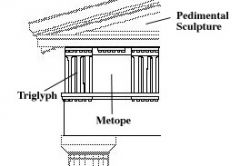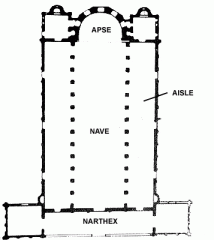![]()
![]()
![]()
Use LEFT and RIGHT arrow keys to navigate between flashcards;
Use UP and DOWN arrow keys to flip the card;
H to show hint;
A reads text to speech;
51 Cards in this Set
- Front
- Back
|
post and lintel |
a structure consisting of vertical beams (posts) supporting a horizontal beam (lintels) STONEHENGE 2500 BCE |
|
|
registers |
lines to divide sections (Palette of Narmer) |
|
|
hierarchical scale |
technique in which the artist uses an unnatural scale or proportion in order to depict the importance of the figures in the work |
|
|
mastaba |
an ancient Egyptian tomb rectangular in shape with sloping sides and a flat roof. underground burial chamber |
|
|
canon of proportions |
egyptian measurement. 18 equal squares for stone carvings and paintings (Menkaure and his Queen) 2500 BCE |
|
|
axial plan |
the horizontal arrangement of the parts of a building, city streets or a town. parts of the building are arranged longitudinally |
|
|
pylon |
the wide entrance gateway of an egyptian temple, characterized by its sloping walls |
|
|
hypostyle hall |
a roof which is supported by columns |
|
|
clerestory |
a level of architecture between two stories or roofs. Often has high windows above eye level to bring in light (common in roman and midevil churches- also in palace at Knossos) |
|
|
ziggurat |
a rectangular stepped tower, sometimes surrounded by a temple |
|
|
bent-axis plan |
a plan that incorporates two or more angular changes of directions (Ziggurat at Ur) |
|
|
stele |
upright stone monument with inscriptions. often used as grave markers for dedication and commemoration. usually rectangles carved in relief |
|
|
megaron |
great hall of Grecian palace complexes. rectangular, and often fronted by an open, columned porch- central and surrounded by columns |
|
|
tholos |
round structure, usually built upon a few steps (a podium) with a ring of columns supporting a domed roof |
|
|
kouros |
archaic greek statue of a young man, often naked (Kroisos Kouros) |
|
|
kore |
archaic greek statue of a young woman, standing in loose clothing |
|
|
doric order |
ancient greek system for articulating the three units of the elevation of a classical building- the platform, the colonnade and the superstructure. Doric order is characterized by capitals with funnel-shaped columns without bases and frieze of triglyphs and metopes (Parthenon) |
|
|
Ionic order |
volutes, capitals, columns and bases with an uninterrupted frieze |
|
|
cella (naos) |
the inner area of an ancient temple, especially one housing the hidden cult image |
|
|
pediment |
the triangular upper part of the front of a building in classical style, typically surrounding a portico of columns (parthenon) |
|
|
triglyphs/metopes |

a tablet in doric frieze with three vertical grooves. triglyphs alternate with metopes. |
|
|
entasis |
a slight convex curve in the shaft of a column, introduced to correct the visual illusion of concavity produced by a straight shaft (parthenon) |
|
|
black figure vase painting |
early greek pottery, silhouetting of dark figures against a light background of natural, reddish clay with linear details (Ajax and Achilles playing a board games) 540-530 BCE |
|
|
red figure vase painting |
in later greek pottery- reverse of black figure |
|
|
bilingual pot |
red and black vase painting |
|
|
classical |
of or relating to ancient Greek, regarded as representing an exemplary standard; traditional and long-established in form or style |
|
|
CONTRAPPOSTO |
disposition of the human figure in which one part of the body is turned in opposition to another part (usually the hips and legs are one way and the shoulders and chest are another) creating a counterpositioning of the body about its central axis. sometimes called a weight shift (Kritios Boy) |
|
|
Canon |
a general law, rule, principle by which something is judged (Kririos boy) |
|
|
Polykleitos |
the elder, was a greek sculptor in bronze in the 5th and early 4th century (Doryphoros) |
|
|
Myron |
working 440-480 BCE, an athenian sculptor (Discobolus---Hellenistic) |
|
|
Phidias |
ancient greek sculptor (500-432 BC) who did the frieze of the Parthenon |
|
|
wet drapery |
cloth that appears to cling to the body in animated folds while it reveals the contours of the human figure. this sculptural characeristic can be found from classical to hellenistic greek sculpture. (Venus de Milo) |
|
|
barrel vault/groin vault |
a vault forming a half cylinder, 4 arches together |
|
|
forum |
a public square in and ancient Roman city (forum of Trajan) |
|
|
BASILICA |
(nave, asiles, apse)- a large oblong hall or building with double colonnades and a semicurcular apse (a large recess in a church, arched with a domed roof and often contains altar), used in ancient Rome as a court of law for public assemblies. Intended to accomodate most of the congregation (basilica Ulpia) |
|
|
Coffering |
sunken panel in the shape of a square, rectangle or octagon in a ceiling or vault to reduce the amount of cement used (pantheon) |
|
|
triumphal arch |
a monumental archway, usually built to commemorate some notable victory (arch of Titus) |
|
|
sarcophagus |
a stone coffin, typically adorned with a sculpture or inscription and associated with the ancient civilizations of egypt, rome and greece (Sarcophagus of Junias Bassus) |
|
|
spolio |
using pre-existing architecture on other architecture (arch of titus) |
|
|
transept |
either of the two parts forming the arms of the cross shape, projecting at the right angles from the nave |
|
|
narthex |
entrance or lobby area, usually located at the west end of the nave, opposite the main alar |
|
|
ambulatory |
a place for walking, especially and altar around the apse |
|
|
mosaic |
a picture or pattern produced by arranging together small colored pieces of hard material such as stone, tile or glass (tessera). Common in Byzantine art |
|
|
tessera |
small colored pieces of small material used in mosaic |
|
|
illumination |
lighting or light |
|
|
dyptich |
painting, especially an altarpiece, on two hinged wooden panels that may be closed like a book |
|
|
pendentive |
a curved triangle of vaulting formed by the intersection of a dome with its supporting arches |
|
|
squinch |
a straight or arched structure across an interior angle of a square tower to carry a superstructure such as a dome |
|
|
icon |
a painting of jesus christ or another holy figure, typically in a traditional style on wood, venerated and used as an aid to devotion in the byzantine and other eastern churches |
|
|
iconoclasm |
the action of attacking or assertively rejecting cherished beliefs and institutions or established values and practices |
|
|
basilica plan |

|

